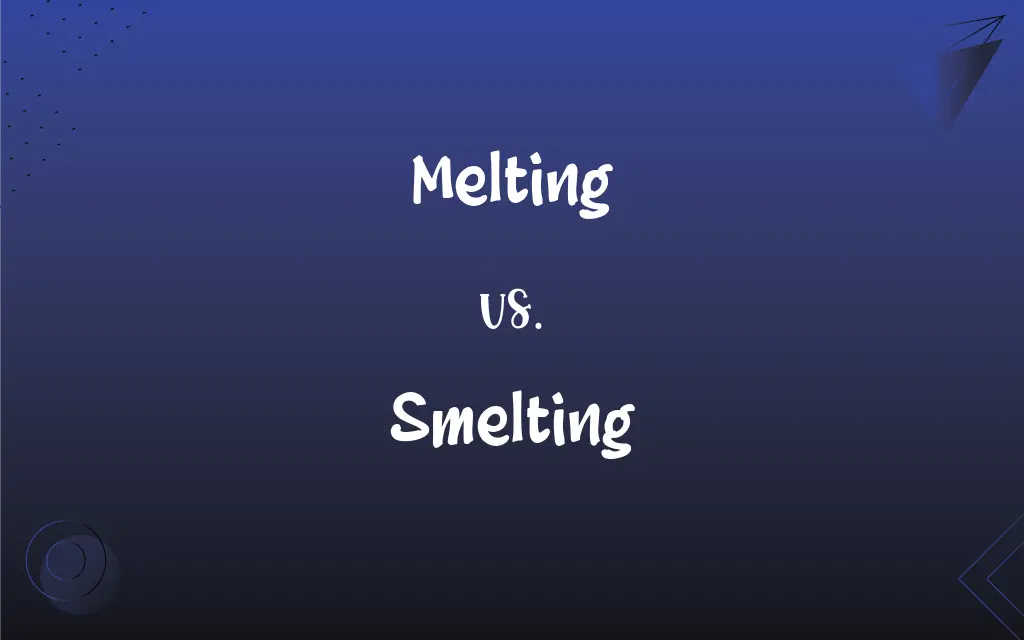Melting vs. Smelting: What's the Difference?
Edited by Aimie Carlson || By Harlon Moss || Updated on October 19, 2023
Melting is the process of turning a solid into a liquid due to heat, while smelting is the extraction of metal from its ore using heat and a reducing agent.

Key Differences
Melting and smelting are both processes involving heat, but they serve different purposes in metallurgy and everyday scenarios. Melting refers to the transition of a substance from its solid form to its liquid form due to an increase in temperature. It's a phase change that doesn't alter the substance's chemical composition. For example, an ice cube melting turns into water, but the substance remains H2O throughout the process.
Smelting, on the other hand, is a chemical process specifically designed to extract metals from their ores. It's more than just melting; it involves using a reducing agent, typically carbon in the form of coke, to chemically reduce metal compounds and separate them from impurities. When smelting iron ore, for example, the iron is separated from the non-metallic components.
It's essential to understand that while all smelting involves melting, not all melting is smelting. Melting is a broader term applicable to any solid turning into a liquid, whether it's chocolate, wax, or ice. Smelting, being a specialized process, only applies to the extraction of metals from their natural mineral deposits.
The end products of both processes are also different. After melting, the result is simply the liquid form of the original material. With smelting, the end goal is to produce a pure metal or alloy, free from unwanted impurities or contaminants.
In everyday language, melting is a term more commonly encountered as it applies to a variety of materials and scenarios, from cooking to seasonal changes. Smelting is a term more specific to metallurgy, primarily associated with metal extraction and processing industries.
ADVERTISEMENT
Comparison Chart
Definition
Turning a solid into a liquid due to heat.
Extraction of metal from ore using heat & a reducing agent.
Chemical Change
No
Yes
Application
General (e.g., melting ice)
Specific to metallurgy (e.g., extracting iron from ore)
End Product
Liquid form of the original material.
Pure metal or alloy.
Reducing Agent Required
No
Yes
ADVERTISEMENT
Melting and Smelting Definitions
Melting
Physical change without altering the substance's composition.
The melting wax maintained its scent.
Smelting
Transformation of ore into a free metal.
Iron ore undergoes smelting to produce iron.
Melting
Phase change due to increased temperature.
The butter started melting as soon as it hit the hot pan.
Smelting
Metallurgical method using heat and a reducing agent.
The ancient civilizations used primitive smelting techniques.
Melting
Becoming tender or compassionate.
Her heart started melting when she heard the touching story.
Smelting
Production of pure metal or alloy.
The objective of smelting is to produce usable metal.
Melting
Transition of a substance from solid to liquid.
Ice is melting on the sidewalk.
Smelting
Chemical reduction of metal compounds.
Smelting separates the metal from impurities.
Melting
Dissolving or softening under heat.
The chocolate began melting the moment it was exposed to the sun.
Smelting
Process to extract metal from its ore.
Smelting is crucial in obtaining pure metals.
Melting
To be changed from a solid to a liquid state especially by the application of heat.
Smelting
To melt or fuse (ores) in order to separate the metallic constituents.
Melting
To dissolve
Sugar melts in water.
Smelting
To melt or fuse. Used of ores.
Smelting
A past tense and a past participle of smell.
Smelting
Present participle of smelt
Smelting
(metallurgy) The process of melting or fusion, especially to extract a metal from its ore.
FAQs
What's the primary purpose of smelting?
Smelting aims to extract metals from their ores.
Can smelting occur without melting?
No, smelting involves the melting of ore as part of the process.
Does the chemical composition change during melting?
No, the composition remains the same during melting.
Why are reducing agents needed in smelting?
They help in the chemical reduction of metal compounds.
Is melting a chemical or physical change?
Melting is a physical change.
Is smelting an ancient technique?
Yes, ancient civilizations had their smelting methods.
What's the difference between melting and boiling?
Melting turns a solid into a liquid, while boiling turns a liquid into a gas.
What's the main challenge in smelting?
The challenge is to separate the metal from impurities efficiently.
Is melting reversible?
Yes, by cooling the liquid, you can revert it to a solid.
Is smelting used for all metals?
No, some metals, like gold, require other methods since they are often found in a nearly pure state.
Why is smelting important?
Smelting is essential for obtaining usable metals from their naturally occurring minerals.
Is the melting point the same for all substances?
No, different substances have different melting points.
What are the byproducts of smelting?
Byproducts can include slag, gases, or other impurities separated from the metal.
Can melting occur at room temperature?
Yes, for substances with a melting point at or below room temperature.
Which is more energy-intensive, melting or smelting?
Smelting is usually more energy-intensive due to the chemical reactions involved.
What is a reducing agent in smelting?
It's a substance that helps in reducing metal compounds, often carbon in the form of coke.
Can any solid material undergo melting?
Yes, any solid can melt if subjected to its specific melting point temperature.
What happens after a substance melts?
It becomes a liquid and, if heated further, may evaporate.
Is the melting point of a substance fixed?
For pure substances, yes. But mixtures can have a range.
Can substances melt in space?
Yes, if subjected to the right conditions and temperatures.
About Author
Written by
Harlon MossHarlon is a seasoned quality moderator and accomplished content writer for Difference Wiki. An alumnus of the prestigious University of California, he earned his degree in Computer Science. Leveraging his academic background, Harlon brings a meticulous and informed perspective to his work, ensuring content accuracy and excellence.
Edited by
Aimie CarlsonAimie Carlson, holding a master's degree in English literature, is a fervent English language enthusiast. She lends her writing talents to Difference Wiki, a prominent website that specializes in comparisons, offering readers insightful analyses that both captivate and inform.
































































